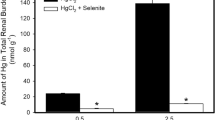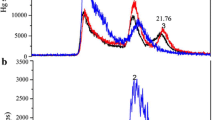Abstract
Recent studies have shown that at a higher mercury (Hg) burden, the molar ratio of selenium (Se) and Hg in tissues tends to approximate 1:1 by the formation of biologically largely inert adducts. From the toxicological standpoint, this trapping of free Hg is welcome. However, this binding of Se to Hg reduces the portion of Se in tissues, which is available for the formation of essential selenoenzymes like glutathione peroxidase, type I deiodase, and so forth and could result in a relative deficiency of Se. Therefore, we tried to determine the concentration of non-Hg-associated Se in several human tissues. As there is no proved trace method for the speciation of non-Hg-bound and Hg-bound Se in tissues, the total concentrations of Hg and Se were determined and the portion of non-Hg-associated Se was calculated by the difference of the molar concentrations of Se and Hg. For this investigation, the following tissues were obtained by autopsy from 133 adults: kidney cortex, thyroid gland, liver, spleen, cerebrum cortex, and pituitary gland. In no case was an occupational Hg burden known. The results confirm the assumption of a 1:1 association of Hg and Se in human tissues. The mean concentration of non-Hg-bound Se was calculated to 576 µg/kg in the kidney cortex, 363 µg/kg in the thyroid gland, 308 µg/kg in the liver, 205 µg/kg in the spleen, 111 µg/kg in the cerebrum cortex, and 545 µg/kg in the pituitary gland. In none of the cases under investigation in any tissue was the molar Se/He ratio below 1. This means that a total deficiency of non-Hg-bound Se could not be seen in this normal population, even at a higher Hg burden. Nevertheless, at a suboptimal Se supply like in Germany, any reduction of the part of Se, which is available for the formation of essential seleno-enzymes, should be avoided. Therefore, any additional Hg burden such as from dental amalgam should to be considered critically. The different distribution of Hg and Se in the body confirms that there is a controlled hierarchy in the Se supply of different organs, which tries to prevent a Se deficiency in organs with essential seleno-enzymes like the thyroid gland even under an suboptimal Se supply.
Similar content being viewed by others
References
G. Drasch, E. Wanghofer, G. Roider, and S. Strobach, Correlation of mercury and selenium in the human kidney, J. Trace Elements Med. Biol. 10, 251–254 (1996).
L. Kosta, A. R. Byrne, and V. Zelenko, Correlation between selenium and mercury in man following exposure to inorganic mercury, Nature 254, 238–239 (1975).
M. Nylander, L. Friberg, and B. Lind, Mercury concentrations in the human brain and kidneys in relation to exposure from dental amalgam fillings, Swed. Dent. J. 11, 179–187 (1987).
J. Yoshinaga, N. Matsuo, H. Imai, M. Nakazawa, T. Suzuki, M. Morita, et al., Interrelationship between the concentrations of some elements in the organs of Japanese with special reference to selenium-heavy metal relationships, Sci. Total Environ. 91, 127–140 (1990).
A. R. Byrne, M. Skreblin, K. Al-Sabti, P. Stegnar, and M. Horvat, Mercury and selenium: perspectives from Idrija, Acta Chim. Slov. 42, 175–198 (1995).
H. E. Ganther, C. Goudie, M. L. Sunde, M. J. Kopecky, P. Wagner, S.-H. Oh, et al., Selenium: relation to decreased toxicity of methylmercury added to diets containing tuna, Science 175, 1122–1124 (1972).
M. Horvat, T. Zvonaric, P. Stegnar, A. Prosenc, D. Konda, and A. Sabadin, Relation between total mercury, methylmercury and selenium in fish muscle from the Adriatic Sea, in International Conference—Heavy Metals in the Environment [Proceedings], J.-P. Vernet, ed., CEP Consultants, Geneva, pp. 370–373 (1989).
T. Kari and P. Kauranen, Mercury and selenium contents of seals from fresh and brackish waters in Finland, Bull. Environ. Contam. Toxicol. 19, 273–280 (1978).
J. H. Koeman, W. S. M. van de Ven, J. J. M. de Goeij, P. S. Tjioe, and J. L. van Haaften, Mercury and selenium in marine mammals and birds, Sci. Total Environ. 3, 279–287 (1975).
R. J. Norstrom, R. E. Schweinsberg, and B. T. Collins, Heavy metals and essential elements in livers of the polar bear (Ursus maritimus) in the Canadian Arctic, Sci. Total Environ. 48, 195–212 (1986).
G. N. Schrauzer, Quecksilber-Selen—Wechselwirkungen und das Zahnamalgam-Problem, in Status Quo and Perspectives of Amalgam and Other Dental Materials, L. T. Friberg and G. N. Schrauzer, eds., Georg Thieme Verlag, Stuttgart, pp. 106–118 (1995).
B. M. Eley, A study of mercury redistribution, excretion and renal pathology in guinea-pigs implanted with powdered dental amalgam for between 2 and 4 years, J. Exp. Pathol. 71, 375–393 (1990).
K. T. Suzuki, C. Sasakura, and S. Yoneda, Binding sites for the (Hg-Se) complex on selenoprotein P, Biochim. Biophys. Acta 1429, 102–112 (1998).
S. Yoneda and K. T. Suzuki, Detoxification of mercury by selenium by bindung of equimolar Hg-Se complex to a specific plasma protein, Toxicol. Appl. Pharmacol. 143, 274–280 (1997).
S. Yoneda and K. T. Suzuki, Equimolar complex binds to Selenoprotein P, Biochem. Biophys. Res. Commun. 231, 7–11 (1997).
N. G. Carmichael and B. A. Fowler, Effects of separate and combined chronic mercuric chloride and sodium selenate administration in rats: histological, ultrastructural and X-ray microanalytical studies of liver and kidney, J. Environ. Pathol. Toxicol. 3, 399–412 (1980).
U. Lindh and E. Johansson, Protective effects of selenium against mercury toxicity as studied in the rat liver and kidney by nuclear analytical techniques, Biol. Trace Element Res. 12, 109–120 (1987).
J. Parizek and I. Ostadalova, The protective effect of small amounts of selenite in sublimate intoxication, Experientia 23, 142–143 (1967).
O. Wada, N. Yamaguchi, T. Ono, M. Nagahashi, and T. Morimura, Inhibitory effect of mercury on kidney glutathione peroxidase and its prevention by selenium, Environ. Res. 12, 75–80 (1976).
S. Mailänder, Selen, Quecksilber und deren Zusammenhang in menschlichen Organen, Thesis. Ludwig-Maximilians-Universität, Munich (1998).
D. Behne, H. Hilmert, S. Scheid, H. Gessner, and W. Elger, Evidence for specific selenium target tissues and new biologically important selenopoteins, Biochim. Biophys. Acta 966, 12–21 (1988).
M. Nylander and J. Weiner, Mercury and selenium concentrations and their interrelations in organs from dental staff and the general population, Br. J. Ind. Med. 48, 729–734 (1991).
O. Oster, G. Schmiedel, and W. Prellwitz, The organ distribution of selenium in German adults, Biol. Trace Element Res. 15, 23–45 (1988).
B. Tiran, E. Karpf, and A. Tiran, Age dependency of selenium and cadmium content in human liver, kidney, and thyroid, Arch. Environ. Health 50, 242–246 (1995).
J. Neve, Methods in determination of selenium states, J. Trace Element Electrolytes Health Dis. 5, 1–17 (1991).
K. S. Subramanian, J. C. Meranger, and R. T. Burnett, Kidney and liver levels of some major, minor and trace elements in two Ontario communities, Sci. Total Environ. 42, 223–235 (1985).
M. Gross, M. Oertel, and J. Köhrle, Differential selenium-dependent expression of type I 5′-deiodinase and gluthathione peroxidase in the porcine epithelial kidney cell line LLC-PK1, Biochem. J. 306, 851–856 (1995).
D. Brune, G. Nordberg, and P. O. Wester, Distribution of 23 elements in the kidney, liver and lungs of workers from a smeltery and refinery in North Sweden exposed to a number of elements and of a control group, Sci. Total Environ. 16, 13–35 (1980).
G. Drasch, I. Schupp, G. Riedl, and G. Günther, Einfluß von Amalgamfüllungen auf die Quecksilberkonzentration in menschlichen Organen, Dtsch. Zahnärztl. Z. 47, 490–496 (1992).
R. Schiele, E. M. Freitag, K. H. Schaller, B. Schellmann, and D. Weltle, Untersuchungen zur normalen Quecksilberkonzentration menschlicher Organe, Zbl. Bakt. Hyg. I. Abt. Orig. B. 173, 45–62 (1981).
J. A. Weiner and M. Nylander, The relationship between mercury concentrations in human organs and different predictor variables, Sci. Total Environ. 138, 101–115 (1993).
C. Drobner, M. Anke, and B. Röhrig, The selenium intake of adults in three federal counties of Germany. In: Ninth International Symposium on Trace Elements in Man and Animals, Banff Centre for Conferences, ed., NRC Research Press, Ottawa (1996).
O. Oster and W. Prellwitz, The daily dietary selenium intake of West German adults, Biol. Trace Element Res. 20, 1–14 (1989).
C. Sasakura and R. T. Suzuki, Biological interaction between transition metals (Ag, Cd and Hg), selenide/sulfide and selenoprotein P, J. Inorg. Biochem. 71, 159–162 (1998).
D. Behne, C. Weiss-Nowak, M. Kalcklösch, C. Westphal, H. Gessner, and A. Kyriakopoulos, Studies on the distribution and characteristics of new mammalian selenium-containing proteins, Analyst 120, 823–825 (1995).
Author information
Authors and Affiliations
Rights and permissions
About this article
Cite this article
Drasch, G., Mailänder, S., Schlosser, C. et al. Content of non-mercury-associated selenium in human tissues. Biol Trace Elem Res 77, 219–230 (2000). https://doi.org/10.1385/BTER:77:3:219
Received:
Revised:
Accepted:
Issue Date:
DOI: https://doi.org/10.1385/BTER:77:3:219




